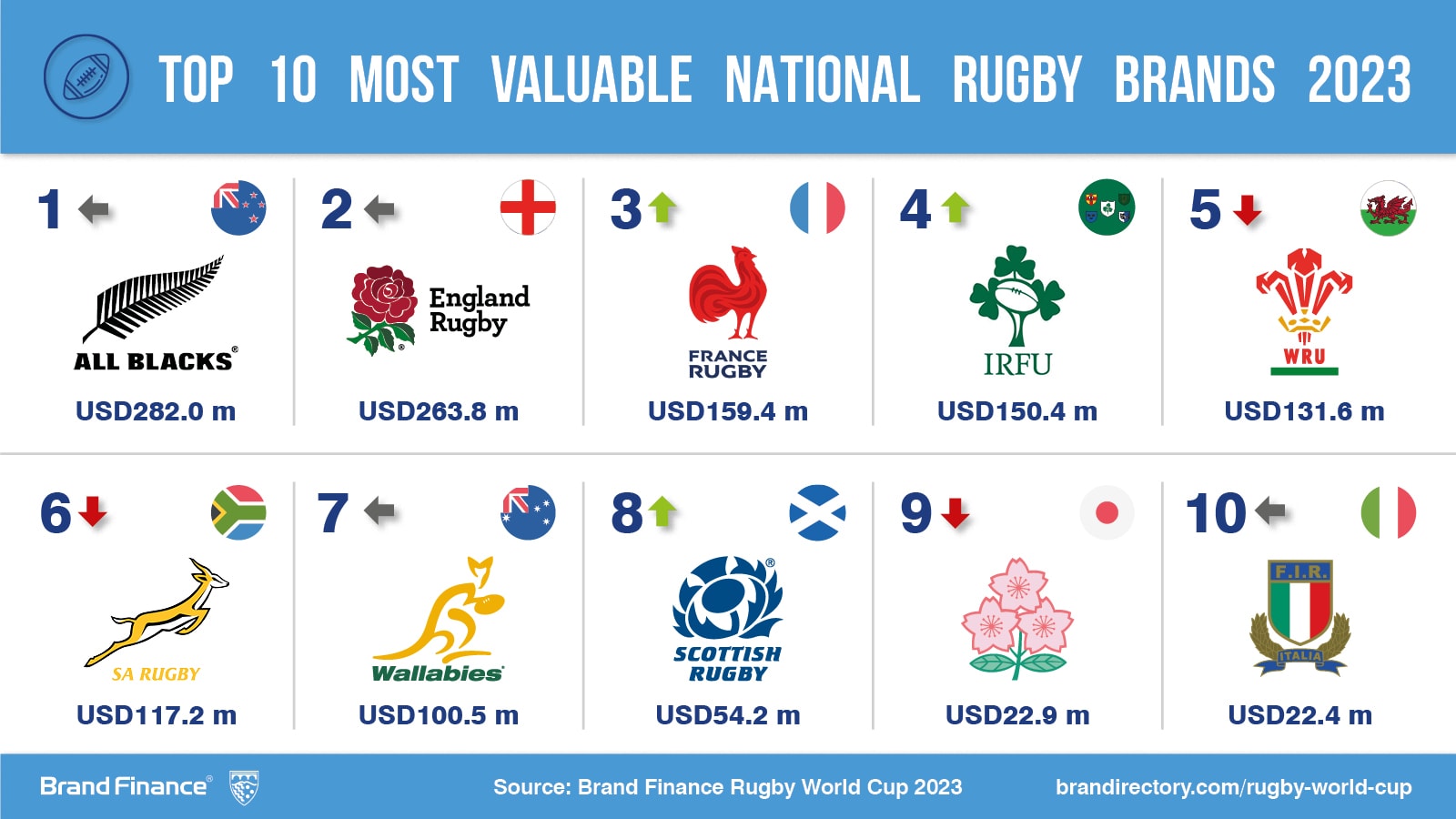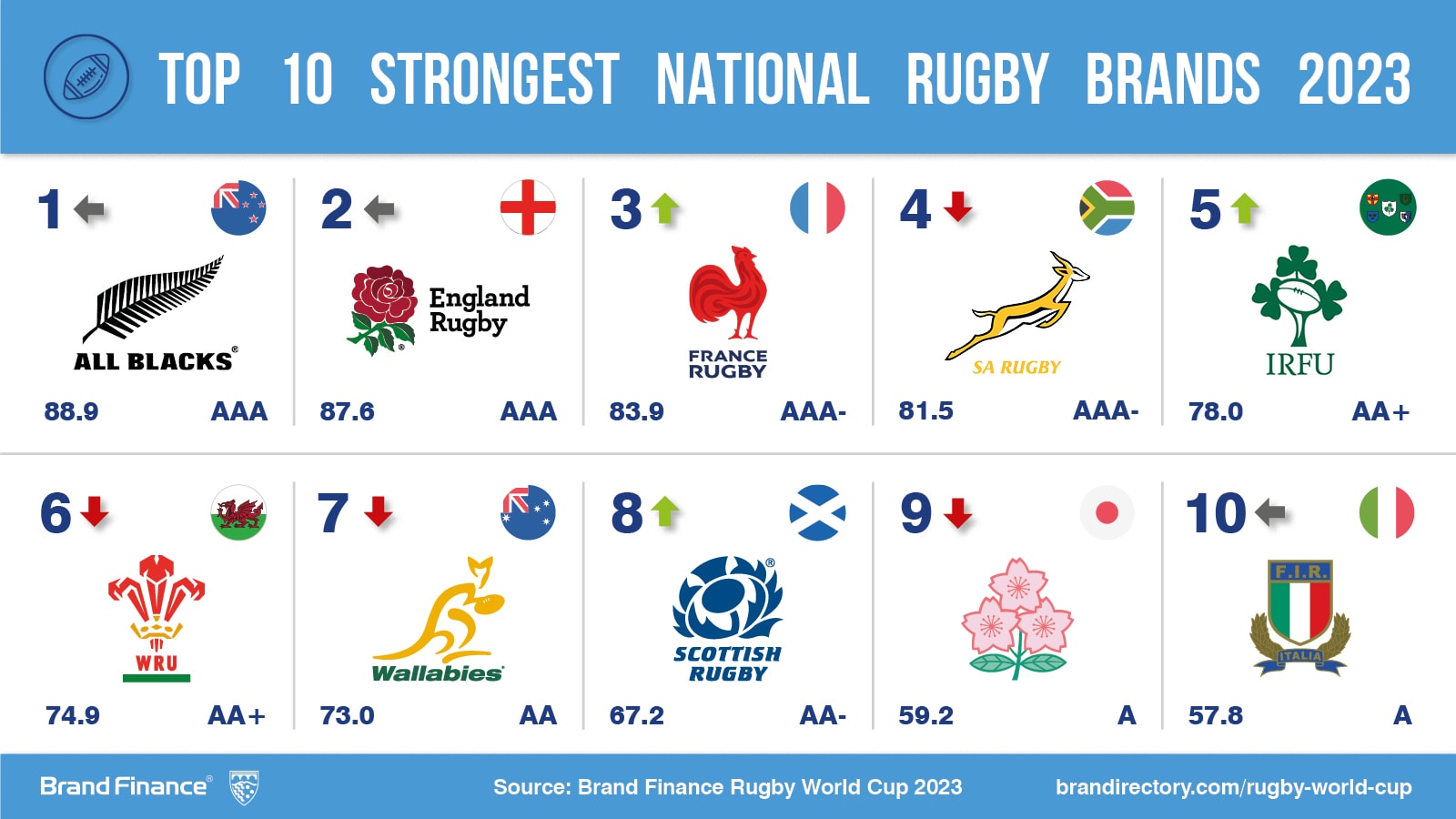View the full Brand Finance Rugby 10 2023 report here
The Springboks have slipped one place in the Brand Finance Rugby 10 2023 ranking to sixth while the All Blacks (brand value up 52% to USD282 million) maintain their status as the world’s most valuable rugby brand. The top five most valuable rugby brands in 2023 are New Zealand, England (brand value up 71% to USD264 million), France (brand value up 84% to USD159 million), Ireland (brand value up 94% to USD150 million), and Wales (brand value up 23% to USD132 million).

The Springbok (brand value up 44% to USD117 million) brand has grown 44% since 2019, but the weakening rand has meant it has lost one place as Ireland leapfrogged the Boks to move from sixth to fourth.
The Springboks did however maintain their fourth place in the rankings of strongest brands with a brand strength score of 81.4, up from below 80 in 2019. The Springboks’ improved brand value, in addition to brand strength, is off the back of its 2019 World Cup win and current form. Captained by Siya Kolisi, the national team brand is led by a highly valuable and inspiring role model that adds to the strength and value of the brand.
In addition to the 2019 Rugby World Cup win and current performances, brand value growth has been helped by the increase in sponsorship revenue. Notwithstanding the ongoing commitment from MTN and First National Bank, a 2022 six-year deal with Nike as South Africa Rugby’s apparel provider has helped the increase in brand value. Actual commercial sales of the new jerseys do not impact the current value as merchandise sales only begun in July 2023. The limited quantities, high price and limited distribution partners of the new jerseys may however impact future brand valuations. Springbok replica jerseys are the largest selling national sports item in South Africa and limited supply and high pricing may result in a significant secondary “knock-off” market that will impact SA Rugby’s commercial revenue.
The world’s most valuable rugby brand, the All Blacks, saw their brand value grow 52% to USD282 million despite their on-pitch authority increasingly being challenged by other leading rugby nations. This growth is attributed to robust revenues, particularly in sponsorship and merchandising over the past 4 years. The All Blacks also remain the world’s strongest rugby brand although they have declined from a score of 94.9 in 2019 to under 89 in 2023.
The biggest winners in the 2023 rankings are France moving up to third with their value jumping 84% to USD159 million. Not only has their value seen a significant increase, but their brand strength has grown significantly buoyed by the excitement around the home World Cup, and a team that’s playing exciting rugby.
The largest brand value growth has come from Ireland who moved from sixth to fourth in the rankings. Irelands success on the pitch in the past year resulting in their number 1 world ranking, combined with Ireland Rugby’s strong revenue growth has seen their brand value grow 94% to USD150 million.
In terms of the following of rugby, Brand Finance research shows the highest following of Rugby of any of the 40 major economies researched, is in South Africa at 45%, double the rate of the next two markets England and France (the research does not include the Pacific Islands or New Zealand).
In the latest Brand Finance Global Soft Power Index, data shows that other top rugby nations are more likely to see South Africa as a leader in sport (averaging 11th place vs 19th globally) and are slightly more familiar because of South Africa’s success on the sports field. They do however give South Africa a lower overall Soft Power Index, demonstrating that the exposure and sporting perceptions are not rubbing off on other areas, and perhaps the greater familiarity has made people more aware of flaws in Governance, Education, and People & Values, where South Africa scores relatively weakly.

Brand Finance is the world’s leading brand valuation consultancy. Bridging the gap between marketing and finance, Brand Finance evaluates the strength of brands and quantifies their financial value to help organisations make strategic decisions.
Headquartered in London, Brand Finance operates in over 25 countries. Every year, Brand Finance conducts more than 6,000 brand valuations, supported by original market research, and publishes over 100 reports which rank brands across all sectors and countries.
Brand Finance also operates the Global Brand Equity Monitor, conducting original market research annually on 6,000 brands, surveying more than 175,000 respondents across 41 countries and 31 industry sectors. By combining perceptual data from the Global Brand Equity Monitor with data from its valuation database — the largest brand value database in the world — Brand Finance equips ambitious brand leaders with the data, analytics, and the strategic guidance they need to enhance brand and business value.
In addition to calculating brand value, Brand Finance also determines the relative strength of brands through a balanced scorecard of metrics evaluating marketing investment, stakeholder equity, and business performance, compliant with ISO 20671.
Brand Finance is a regulated accountancy firm and a committed leader in the standardisation of the brand valuation industry. Brand Finance was the first to be certified by independent auditors as compliant with both ISO 10668 and ISO 20671 and has received the official endorsement of the Marketing Accountability Standards Board (MASB) in the United States.
Brand is defined as a marketing-related intangible asset including, but not limited to, names, terms, signs, symbols, logos, and designs, intended to identify goods, services, or entities, creating distinctive images and associations in the minds of stakeholders, thereby generating economic benefits.
Brand strength is the efficacy of a brand’s performance on intangible measures relative to its competitors. Brand Finance evaluates brand strength in a process compliant with ISO 20671, looking at Marketing Investment, Stakeholder Equity, and the impact of those on Business Performance. The data used is derived from Brand Finance’s proprietary market research programme and from publicly available sources.
Each brand is assigned a Brand Strength Index (BSI) score out of 100, which feeds into the brand value calculation. Based on the score, each brand is assigned a corresponding Brand Rating up to AAA+ in a format similar to a credit rating.
Brand Finance calculates the values of brands in its rankings using the Royalty Relief approach – a brand valuation method compliant with the industry standards set in ISO 10668. It involves estimating the likely future revenues that are attributable to a brand by calculating a royalty rate that would be charged for its use, to arrive at a ‘brand value’ understood as a net economic benefit that a brand owner would achieve by licensing the brand in the open market.
The steps in this process are as follows:
1 Calculate brand strength using a balanced scorecard of metrics assessing Marketing Investment, Stakeholder Equity, and Business Performance. Brand strength is expressed as a Brand Strength Index (BSI) score on a scale of 0 to 100.
2 Determine royalty range for each industry, reflecting the importance of brand to purchasing decisions. In luxury, the maximum percentage is high, while in extractive industry, where goods are often commoditised, it is lower. This is done by reviewing comparable licensing agreements sourced from Brand Finance’s extensive database.
3 Calculate royalty rate. The BSI score is applied to the royalty range to arrive at a royalty rate. For example, if the royalty range in a sector is 0-5% and a brand has a BSI score of 80 out of 100, then an appropriate royalty rate for the use of this brand in the given sector will be 4%.
4 Determine brand-specific revenues by estimating a proportion of parent company revenues attributable to a brand.
5 Determine forecast revenues using a function of historic revenues, equity analyst forecasts, and economic growth rates.
6 Apply the royalty rate to the forecast revenues to derive brand revenues.
7 Discount post-tax brand revenues to a net present value which equals the brand value.
Brand Finance has produced this study with an independent and unbiased analysis. The values derived and opinions presented in this study are based on publicly available information and certain assumptions that Brand Finance used where such data was deficient or unclear. Brand Finance accepts no responsibility and will not be liable in the event that the publicly available information relied upon is subsequently found to be inaccurate. The opinions and financial analysis expressed in the study are not to be construed as providing investment or business advice. Brand Finance does not intend the study to be relied upon for any reason and excludes all liability to any body, government, or organisation.
The data presented in this study form part of Brand Finance's proprietary database, are provided for the benefit of the media, and are not to be used in part or in full for any commercial or technical purpose without written permission from Brand Finance.